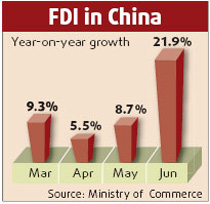The World Bank's (WB) forecast for China's 2007 growth remains unchanged at 11.3 percent. It predicted more than 8 percent economic growth for East Asia in 2007 despite growing concerns about the US sub-prime crisis and rising oil prices.
The WB released the same projection for China's gross domestic product (GDP) growth in its quarterly report in September after revising its estimated growth rate from 9.6 percent to 10.4 percent in May.
In the latest six-monthly report on the economic and social health of the East Asia and Pacific region, the WB said that although East Asian exports to the United States have slowed, more buoyant investment and consumption in China and other countries has allowed growth to remain strong and even pick up this year.
China's GDP grew by 11.5 percent in the first three quarters of 2007 from the same period last year, decreasing from 11.9 percent in the second quarter but higher than 11.1 percent in the first quarter.
The nation's total retail sales grew 15.9 percent year on year in the first three quarters of this year, 2.4 percentage points higher than in the same period of 2006, according to the National Bureau of Statistics (NBS).
Liu Yuanchun, deputy director of the Economics Institute of the Renmin University of China, said that the sustained growth of people's income, still slower than the GDP growth, was the biggest impetus behind consumption growth.
A new acceleration in investment spending provided the main impulse for the rise in China's GDP growth in 2007, reflecting fundamental factors such as rapid profit growth, rising profit margins and still relatively low lending rates, according to the report.
China's fixed assets investments rose to 9,152.9 billion yuan (US$1,220.4 billion) in the first nine months, up 25.7 percent from the same period last year.
"The government has increased the cost of investments to discourage the start of new projects," said Song Guoqing, a researcher with Peking University. "This puts small and medium-sized private enterprises under considerable pressure, but has had little effect on large state-owned firms."
The report cautioned that new highs for oil prices will test the solidity of the East Asian and global economic expansions in 2008, saying that an average per barrel oil price of US$90 in 2008 would be associated with an income loss in East Asia of a little over 1 percent of GDP.
Crude oil prices neared the US$100 per barrel mark in early November, underpinned by demand and supply factors and boosted by geo-political and financial short-term factors.
Faced with worsening fuel shortages in the country, China raised petrol, diesel and jet fuels prices by nearly 10 percent to about US$76 a barrel to boost domestic supplies but its wholesale petrol prices are still lower than the international average of 102 dollars.
This means that the Chinese government has to continue offering large amount of subsidies to refineries to cover losses they incur by selling oil at state-set prices. The government subsidized Sinopec, the nation's largest refinery company, to the tune of US$1.2 billion in 2005 and US$640 million in 2006.
In the meantime, soaring oil prices add to the financial burden for enterprises and individuals, and likewise increase inflationary risks. China's consumer price index (CPI), a main gauge of inflation, rose 6.5 percent year-on-year in October.
The impact of the US subprime crisis and the renewed surge in oil prices have clearly increased downside risks, but the stronger growth momentum in the region is expected to carry through 2008, said Milan Brahmbhatt, the report's lead author.
The bank stood by its forecast for the galloping Chinese growth in 2008 of a slightly lower 10.8 percent and predicted only a moderately slowdown from 2007 in East Asia's economies growth in 2008.
According to the report, emerging East Asia experienced its largest increase in foreign exchange reserves during 2007. Forex reserves for the nine largest economies increased by US$451 billion during the first nine months and reached US$2.5 trillion.
China claimed four-fifths of the regional reserve increases this year with US$367.3 billion, as its total forex reserve has topped US$1.43 trillion by the end of September.
As reported on November 7, the nation has set up a state forex investment company, China Investment Corporate Ltd. (CIC), to mitigate the risks in its huge foreign exchange reserve.
The company, with US$200 billion in registered capital and US$208 billion from a special treasury bond sale by the Ministry of Finance, would not buy into overseas airlines, telecommunications or oil companies, China's Vice-Minister of Finance Li Yong said on November 7.
It will use one third of its capital to purchase Central Huijin, which now controls China's major state-owned commercial banks, another third to replenish the capital of the Agricultural Bank of China and China Development Bank, and the remaining third to invest in global financial markets, he added.
A highlight of the WB report is that for the first time, the number of poor people living on less than two dollars a day in East Asia has fallen below 500 million, down from 1 billion in 1990.
In percentage terms this means the poverty head-count rate is estimated to have fallen to about 27 percent, down from 29.5 percent in 2006 and 69 percent in 1990, said the report.
(Xinhua News Agency November 15, 2007)


